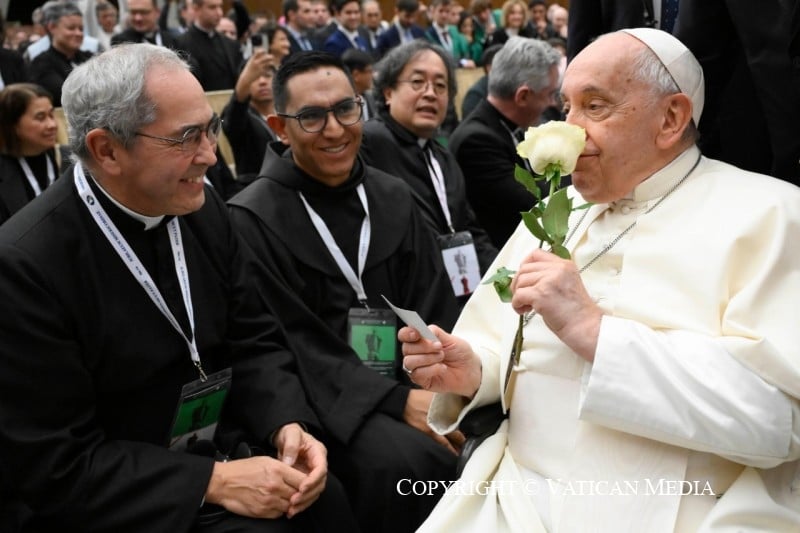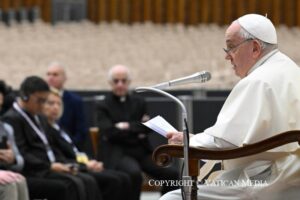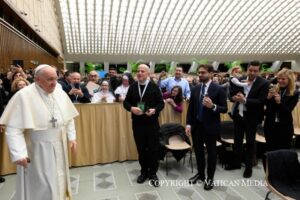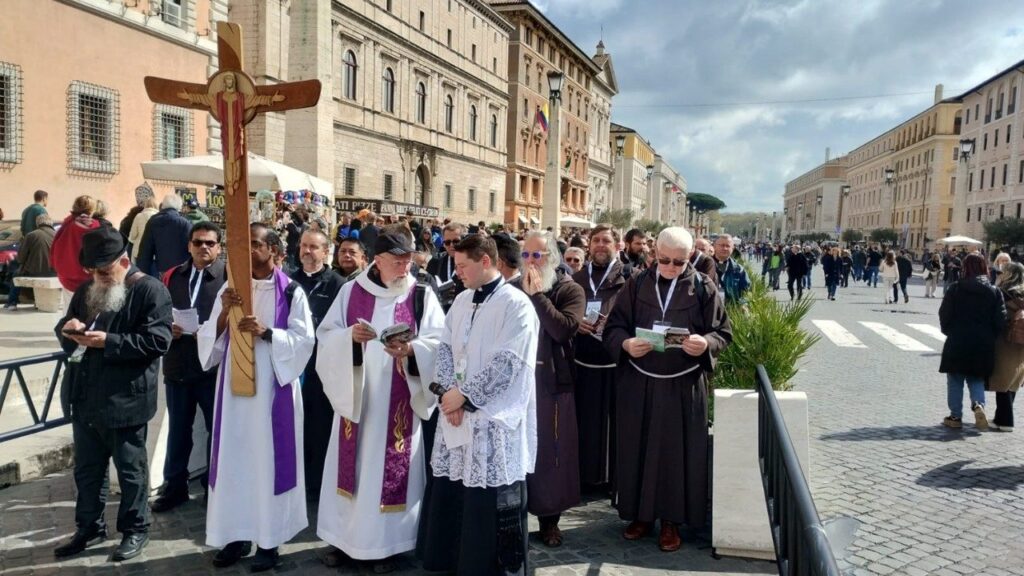“The Shrine: house of prayer”
The Pope at the II International Meeting for Shrine Rectors and Shrine Workers

In his address to the participants of the 2nd International Meeting for Rectors and Shrine Workers, Pope Francis stressed the importance of shrines as places of encounter with God, consolation, and hope.
Prayer
Pope Francis began his address by recalling that shrines are privileged places of prayer. In them, the faithful can encounter God in a special way, through the celebration of the Eucharist, confession, and adoration.
In particular, Pope Francis stresses the importance of confession. He recalls that the sacrament of reconciliation is a place of forgiveness, where the faithful can find peace and reconciliation with God.
Consolation
Pope Francis also points out that shrines are places of consolation. In them, the faithful who are suffering can find the closeness of God and his Mother, the Virgin Mary.
Pope Francis reminds us that God’s consolation is not an abstract idea, but a real experience that manifests itself in God’s closeness, compassion and tenderness.
Hope
Finally, Pope Francis affirms that shrines are places of hope. In them, the faithful can find the strength to face the future with confidence.
Pope Francis reminds us that hope is a gift from God, to be received through prayer and faith.
We publish below the speech that the Pope addressed to those present during the Audience:
 Address of the Holy Father
Address of the Holy Father
Dear friends, good morning!
I welcome you on the occasion of your second International Meeting, because you are well aware of my care for the life of Shrines. I thank Archbishop Fisichella for this initiative, and for the commitment of the Dicastery to the pastoral care of Shrines. They are special places, where the holy faithful people of God gather to pray, to be consoled and to look to the future with greater confidence.
One comes to the Shrine, above all, to pray. On our part, it is necessary for us to remain ever mindful that our Shrines are truly privileged places of prayer. I know how carefully the Holy Eucharist is celebrated there and how much effort is devoted to the Sacrament of Reconciliation. I recommend that, in the choice of priests for confessions, there should be good discernment, so that it does not happen that those who come to the confessional attracted by the Father’s mercy encounter obstacles to experiencing true and full reconciliation. The Sacrament of Reconciliation is to forgive, always. To forgive. It cannot happen, especially in shrines, that they find obstacles; no, it cannot happen, because in them God’s mercy demands to be expressed in a superabundant way, by their very nature. This is how the faithful rightly perceive them: as special places in which to encounter God’s grace. Always forgive as the Father forgives. Forgive.
In the history of every Shrine it is easy to touch directly the faith of our faithful people, which must be kept alive and nurtured with prayer, primarily the Rosary, which helps to pray through meditation on the mysteries of the life of Jesus and the Virgin Mary. To enter spiritually in those mysteries, to feel one is a living part of what constitutes our history of salvation, is a sweet commitment that brings the flavour of the Gospel to everyday life.
It is important that, in the Shrines, particular attention is dedicated to adoration. We have lost something of the sense of adoration. We must regain it. Perhaps we need to realize that the ambience and atmosphere of our churches do not always invite people to gather and worship. We must encourage pilgrims to experience contemplative silence – and it is not easy – adoring silence. This means helping them to fix their gaze on the essentials of faith. Adoration is not a departure from life; rather it is the space to give meaning to everything, to receive the gift of God’s love and to be able to bear witness to it in fraternal charity. And we can ask the question: “What about me, am I used to the prayer of adoration?” It is important to answer.
One goes to Shrines also to be consoled. The mystery of consolation. How many people go there because they bear in the spirit and the body a weight, a suffering, a worry! The sickness of a loved one, the loss of a family member; so many situations in life are often the cause of loneliness and sadness, which are laid on the altar and await a response. Consolation is not an abstract idea, and is not made up first and foremost of words, but of a compassionate and tender closeness that understands pain and suffering. Compassionate and tender closeness. This is God’s style: close, compassionate and tender. This is the way of the Lord. To console is to make God’s mercy tangible; that is why the service of consolation cannot be missing from our Shrines. Those who care for the Shrine must make the Apostle’s words their own: He comforts us in all our affliction, so that we may be able to comfort those who are in any affliction, with the comfort with which we ourselves are comforted” (2 Cor 1:4). One, two, three, four, five times – in two lines – the word comfort, to comfort; it is dense in Paul’s text. I can be an effective sign of comfort to the extent that I have personally experienced being comforted by the salvific suffering of Jesus and have found refuge in Him. Do not forget. In our history, each one of us has difficult, ugly moments in which the Lord has comforted us. Do not forget this. And remembering our own experience of consolation will help us to console others. And this experience passes through the motherhood of Mary, the “Consolata” par excellence. May consolation and mercy abound in our Shrines!
 Finally, one goes to the Shrine to look to the future with greater confidence. Pilgrims need hope. They seek it in the very gesture of pilgrimage: they set out in search of a safe destination to reach. They ask for hope in prayer, because they know that only a simple and humble faith can obtain the grace they need. So, it is important that, returning home, they feel this has been fulfilled, and are filled with serenity because they have placed their trust in God. In our shrines, great care is taken to welcome – please do not forget this: welcome pilgrims well – and rightly so. At the same time, just as much pastoral care must be given to the moment when pilgrims leave the shrine to return to their ordinary lives: that they receive words and signs of hope, so that the pilgrimage they have made achieves its full meaning.
Finally, one goes to the Shrine to look to the future with greater confidence. Pilgrims need hope. They seek it in the very gesture of pilgrimage: they set out in search of a safe destination to reach. They ask for hope in prayer, because they know that only a simple and humble faith can obtain the grace they need. So, it is important that, returning home, they feel this has been fulfilled, and are filled with serenity because they have placed their trust in God. In our shrines, great care is taken to welcome – please do not forget this: welcome pilgrims well – and rightly so. At the same time, just as much pastoral care must be given to the moment when pilgrims leave the shrine to return to their ordinary lives: that they receive words and signs of hope, so that the pilgrimage they have made achieves its full meaning.
I wanted next year, in preparation for the 2025 Jubilee, to be entirely dedicated to prayer. Next year will be dedicated to prayer. Some guides will be published shortly, which will help rediscover the centrality of prayer. I recommend them to you: they will be a good read, which stimulate prayer with simplicity and in accordance with Christ’s heart. Let us renew every day the joy and commitment to being men and women of prayer. Prayer that comes from the heart, not like parrots. No. From the heart. May the words that are spoken come from the heart. You, in the Shrines, will do this through the typical spirituality that characterizes them.
From all Shrines, may a hymn of thanksgiving to the Lord be raised for the wonders that he achieves even in our times. And may the intercession of the Mother of God be implored, so that, in these troubled times, many of our suffering brothers and sisters may find peace and hope.
I accompany you with my Blessing. And I ask you please, in your Shrines, to remember to pray for me too. Thank you.
____________________________________
Holy See Press Office Bulletin, 11 November 2023
Related

Technology with a Human Face: Pope Francis’ Call for Ethical and Caring Use
Exaudi Staff
01 April, 2025
1 min

Pope Francis Continues Optimistic Recovery and Maintains Work Pace
Exaudi Staff
01 April, 2025
2 min

The Pope to the Missionaries of Mercy: God became man to reveal to the world that he never abandons us!
Exaudi Staff
30 March, 2025
2 min

God’s Mercy and the Call to Peace in Pope Francis’ Angelus
Exaudi Staff
30 March, 2025
3 min
 (EN)
(EN)
 (ES)
(ES)
 (IT)
(IT)

